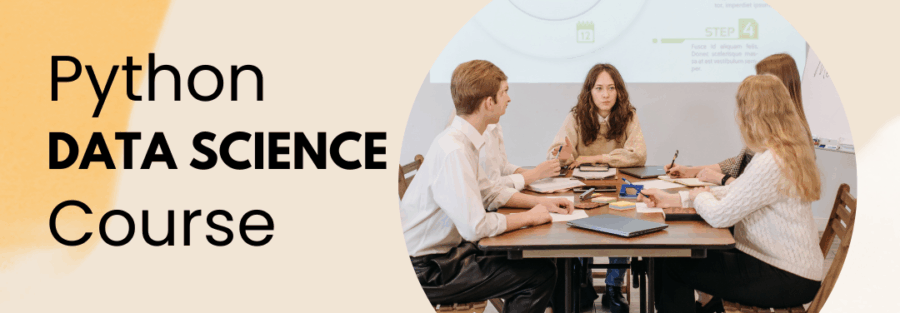Introduction:
Python Data Science course, Python has rapidly evolved into the most preferred programming language in the field of data science and it’s not just hype. Its clean syntax, human-readable structure, and robust community support make it incredibly accessible, even for beginners. Unlike other programming languages that can have a steep learning curve, Python allows you to write and understand code effortlessly, helping you focus on solving real-world data problems rather than struggling with complex programming rules. Cloud Vision Technologies.
What truly sets Python apart is its extensive ecosystem of libraries and tools that cover every stage of the data science pipeline. From importing and cleaning data with Pandas, performing statistical analysis with NumPy or SciPy, building machine learning models using Scikit-learn or TensorFlow, to visualizing insights with Matplotlib or Seaborn Python has it all.
Whether you’re a complete beginner, a developer transitioning into data science, or someone looking to enhance their data analysis skills, learning Python opens the door to a wide range of opportunities. In this guide, we’ll walk you through everything you need to know about using Python in data science, what makes it so powerful, how it’s used in the real world, and what tools you need to get started. Python Data Science course.

What is Data Science?
Data science is a multidisciplinary field that combines programming, statistics, mathematics, and domain expertise to extract valuable insights and knowledge from data. It involves collecting, analyzing, and interpreting vast amounts of structured and unstructured data to help businesses and organizations make data-driven decisions. In the age of big data, data science plays a critical role in uncovering hidden patterns, predicting future outcomes, and solving complex problems. Python Data Science course.
Why Python for Data Science?
Python has become the leading programming language in the world of data science. Its simplicity, flexibility, and a vast collection of libraries make it an ideal choice for data professionals and beginners alike. Let’s explore the main reasons why Python is so widely used in data science. Python Data Science course.
Easy to Learn and Read
Python is known for its clean and readable syntax. Unlike other programming languages that can be complex and confusing, Python feels almost like writing in English. This makes it much easier for beginners to pick up and use effectively, even with no prior programming experience. Data scientists can focus more on solving problems rather than getting stuck in complicated code structures. Python Data Science course.
Extensive Libraries and Frameworks
One of Python’s biggest strengths is its rich ecosystem of libraries specifically designed for data science. Libraries like Pandas and NumPy make it easy to handle and process large datasets. Matplotlib and Seaborn help in creating powerful visualizations, while Scikit-learn, TensorFlow, and PyTorch support everything from basic machine learning to deep learning. These tools simplify complex tasks, making Python a powerful all-in-one solution.
Strong Community Support
Python has one of the largest and most active communities in the programming world. Whether you’re a beginner stuck on a problem or an experienced developer looking for best practices, you’ll find endless support in the form of online tutorials, documentation, and community forums. This active ecosystem makes it easier to learn, troubleshoot, and grow your data science skills faster. Python Data Science course.
Integration and Flexibility
Python can easily integrate with other tools and technologies, including SQL databases, Excel, Big Data platforms, and even cloud services like AWS and Azure. This makes it a highly flexible option that fits into various parts of the data science pipeline from data collection and preprocessing to model deployment and production. Python Data Science course.
Suitable for End-to-End Projects
With Python, you can complete every stage of a data science project using one language. You can collect data, clean it, analyze it, build machine learning models, and even deploy them into real-world applications all within the Python ecosystem. This end-to-end capability saves time and increases productivity, especially in agile and fast-paced environments.
Widely Used in the Industry
Python is trusted by some of the world’s leading companies across industries like finance, healthcare, retail, and tech. It is considered the industry standard for data science, and its popularity ensures a high demand for professionals who know how to use it effectively. Learning Python opens the door to numerous job opportunities and career growth in data science. Python Data Science course.
Essential Python Libraries for Data Science
One of the biggest reasons Python is so popular in data science is its vast ecosystem of libraries. These libraries simplify complex operations, save development time, and help data scientists work more efficiently. Below are the most essential Python libraries that every aspiring data scientist should learn: Python Data Science course.
NumPy
NumPy (Numerical Python) is the foundation for scientific computing in Python. It provides powerful support for creating and working with large multi-dimensional arrays and matrices. NumPy offers a variety of mathematical functions for performing operations like linear algebra, Fourier transforms, and statistical analysis. Most other data science libraries like Pandas and Scikit-learn are built on top of NumPy, making it a must-learn for anyone working with numerical data. Python Data Science course.
Pandas
Pandas is the go-to library for data manipulation and analysis. It introduces two core data structures: Series (1D) and DataFrame (2D), which allow users to load, clean, filter, group, and reshape data with ease. Pandas makes it extremely simple to handle missing values, merge datasets, and perform time-series analysis. It’s the most frequently used library for data preprocessing tasks in the data science pipeline. Python Data Science course.
Matplotlib and Seaborn
Matplotlib is a flexible plotting library that enables you to create static, animated, and interactive visualizations in Python. From bar charts to scatter plots, it offers fine-grained control over every aspect of a graph. Seaborn, built on top of Matplotlib, simplifies complex visualization tasks and provides beautiful default styles and color palettes. Together, they are ideal for Exploratory Data Analysis (EDA), helping data scientists uncover patterns and trends in the data. Python Data Science course.
Scikit-learn
Scikit-learn is a powerful and user-friendly library for machine learning. It offers a wide range of tools for data mining and data analysis, including classification, regression, clustering, dimensionality reduction, model selection, and preprocessing. Its simple and consistent API makes it easy to build, train, test, and evaluate models. Scikit-learn is perfect for beginners entering the world of machine learning with Python. Python Data Science course.
TensorFlow and PyTorch
When it comes to deep learning, TensorFlow and PyTorch are the two most dominant libraries. TensorFlow, developed by Google, provides a flexible platform for building and deploying machine learning models in production. PyTorch, developed by Facebook, is known for its dynamic computation graph and ease of use, making it a favorite among researchers. Both libraries support building neural networks, natural language processing, and computer vision applications. Python Data Science course.
Statsmodels
Statsmodels is a library specifically designed for statistical modeling and hypothesis testing. It provides functions for estimating linear and non-linear models, performing statistical tests, and exploring data through descriptive statistics. If your work involves understanding relationships between variables, statistical forecasting, or working with time-series data, Statsmodels is an excellent choice. Python Data Science course.
Jupyter Notebook
Jupyter Notebook is an open-source web-based interface that allows you to write and run Python code in a highly interactive environment. It supports live code, equations, visualizations, and explanatory text in a single document. Jupyter is especially useful for teaching, testing data science models, and sharing analysis with others. It’s the preferred environment for data scientists when performing exploratory analysis or documenting their workflows. Python Data Science course.

Typical Python Data Science Workflow
A successful data science project follows a well-structured process from collecting data to deploying a model in the real world. Python streamlines this workflow with its powerful tools and libraries that support each phase. Here’s a step-by-step look at a typical Python data science workflow:
Data Collection
The first step in any data science project is acquiring the data. Python makes it easy to import data from various sources such as CSV or Excel files, databases like MySQL or PostgreSQL, APIs, and even web scraping tools. The Pandas library is often used to load and preview datasets using commands like pd.read_csv() or pd.read_sql(). Whether the data comes from a local file or a live stream, Python has the tools to efficiently gather it for analysis. Python Data Science course.
Data Cleaning
Once the data is collected, it usually needs to be cleaned. This involves handling missing values, correcting data types, removing duplicates, and standardizing formats. Pandas provides easy methods like dropna(), fillna(), and astype() to help clean and prepare the data. Clean, consistent data is critical for accurate analysis and model building. Data cleaning may also include outlier detection and feature encoding for categorical variables.
Data Visualization
After cleaning the data, visualizing it is an important step to understand patterns, trends, and relationships. Libraries like Matplotlib, Seaborn, and Plotly allow data scientists to create compelling charts, including histograms, bar charts, line graphs, scatter plots, and heatmaps. Visualizations are not only useful for analysis but also for communicating insights to stakeholders in a more digestible format. Python Data Science course.
Data Analysis
In this stage, data scientists perform exploratory data analysis (EDA) and statistical analysis to extract meaningful information from the dataset. This may involve calculating descriptive statistics (mean, median, standard deviation), identifying correlations, or running hypothesis tests. Python libraries such as NumPy, Pandas, and Statsmodels are commonly used to explore the data and validate assumptions that will guide further modeling.
Machine Learning
Once insights have been gathered from the data, the next step is building machine learning models. With libraries like Scikit-learn, TensorFlow, and PyTorch, Python enables data scientists to build, train, and test models for tasks like classification, regression, clustering, and recommendation systems. Features are selected and fed into algorithms like decision trees, linear regression, random forests, or neural networks depending on the problem.
Model Evaluation
After training a model, it’s essential to evaluate its performance using the right metrics. For classification problems, metrics like accuracy, precision, recall, and F1-score are commonly used. For regression, metrics such as Mean Absolute Error (MAE) or Root Mean Squared Error (RMSE) help determine how well the model is performing. Python’s Scikit-learn library offers built-in functions to easily compute these evaluation scores. Python Data Science course.
Model Deployment
The final step is deploying the model so it can be used in a real-world application. This can be done using Python web frameworks like Flask or FastAPI, which allow you to build APIs that serve the model. Alternatively, you can deploy your models on cloud platforms like AWS (Amazon Web Services), Microsoft Azure, or Google Cloud Platform (GCP) for better scalability and performance. Deployment turns your static model into a dynamic, usable service that can integrate with websites, apps, or internal tools.
Real-World Applications of Python in Data Science
Python’s powerful libraries and flexible capabilities make it a go-to language for solving real-world problems across various industries. Data science, powered by Python, is transforming the way businesses operate, enabling smarter decisions, improved customer experiences, and optimized processes. Below are some key areas where Python is making a significant impact:
Business Intelligence
Python is widely used in business intelligence to help companies make data-driven decisions. One of its primary applications is sales forecasting, where data scientists use historical data and machine learning models to predict future sales trends. Additionally, Python allows businesses to perform customer segmentation by analyzing customer behaviors and characteristics. Python Data Science course.
Using clustering algorithms like K-means or DBSCAN, companies can group customers into different segments and target them with personalized marketing strategies. Python’s capabilities with Pandas and Scikit-learn allow businesses to analyze large datasets, draw meaningful insights, and create actionable reports. Python Data Science course.
Healthcare
In the healthcare industry, Python is transforming patient care and operational efficiency. One major application is predictive diagnosis, where machine learning models are used to predict diseases or health conditions based on historical medical data and patient records. For example, Python-based tools help detect early signs of diseases like cancer, diabetes, or heart conditions. Python Data Science course.
Python’s TensorFlow and Keras are often used in building deep learning models that analyze medical images like X-rays and MRIs. Additionally, Python assists in patient data analysis, enabling healthcare providers to gain insights into patient behaviors, treatment outcomes, and resource allocation.
Finance
The finance industry leverages Python for everything from fraud detection to risk modeling. Fraud detection algorithms analyze patterns in financial transactions to identify unusual or potentially fraudulent activity. By using Python libraries like Scikit-learn and XGBoost, financial institutions can train models to flag suspicious transactions.
Additionally, risk modeling involves assessing the potential risks associated with investments, loans, or trading strategies. Python’s libraries allow analysts to create complex models that estimate market volatility, credit risk, and other financial metrics. Python’s flexibility makes it an essential tool for data-driven decision-making in financial markets.
Marketing
In marketing, Python is widely used for sentiment analysis and A/B testing. Sentiment analysis involves using natural language processing (NLP) techniques to analyze customer feedback, reviews, or social media posts to gauge public sentiment about a product, service, or brand. Python Data Science course.
Python’s NLTK and TextBlob libraries help extract meaning from text data and determine whether sentiments are positive, negative, or neutral. Another key application in marketing is A/B testing, where Python helps run experiments and analyze the results to determine the best version of a product, webpage, or ad campaign. With Python, marketers can optimize their strategies based on real-time data insights.
E-commerce
In the e-commerce sector, Python powers sophisticated tools that drive customer engagement and sales. One of the most popular applications is the recommendation engine, which produces product recommendations for users based on their browsing history, past purchases, and other behaviors. Using collaborative filtering and matrix factorization algorithms, Python helps e-commerce platforms deliver customized recommendations that increase conversion rates. Python Data Science course.
Additionally, Python is used for user behavior analysis, where data scientists analyze website traffic, user interactions, and purchase patterns to optimize user experience and drive sales. Python-based tools allow businesses to segment users and predict which products are most likely to be purchased. Python Data Science course.

Python Data Science course
In today’s data-driven world, data science has emerged as one of the most lucrative and impactful fields. From machine learning to predictive analytics, Python has become the go-to language for data science professionals worldwide. Whether you’re a beginner eager to dive into the world of data science or an experienced professional looking to upgrade your skills, enrolling in a Python Data Science course can provide you with the tools and knowledge to succeed. Python Data Science course.
Conclusion:
Python is a powerful ally in the world of data science. Its user-friendly nature and rich ecosystem of libraries make it the best choice for beginners and professionals alike. With just a laptop and curiosity, you can begin analyzing data and uncovering insights that drive smart decisions. Python Data Science course.
Python’s versatility and range of libraries make it the ideal tool for solving data science problems across industries. Whether it’s improving business processes, enhancing customer experiences, or making better decisions, Python is at the forefront of innovation. By mastering Python, professionals can contribute to impactful solutions in business intelligence, healthcare, finance, marketing, e-commerce, and more.
Address: Cloud Vision Technologies
Location: Samhitha Enclave, 3rd floor, KPHB Phase 9, Kukatpally, Hyderabad, Telangana – 500072
Contact Number : +91 8520002606
Mail ID: info@cloudvisiontechnologies.com
Website: https://www.cloudvisiontechnologies.com



